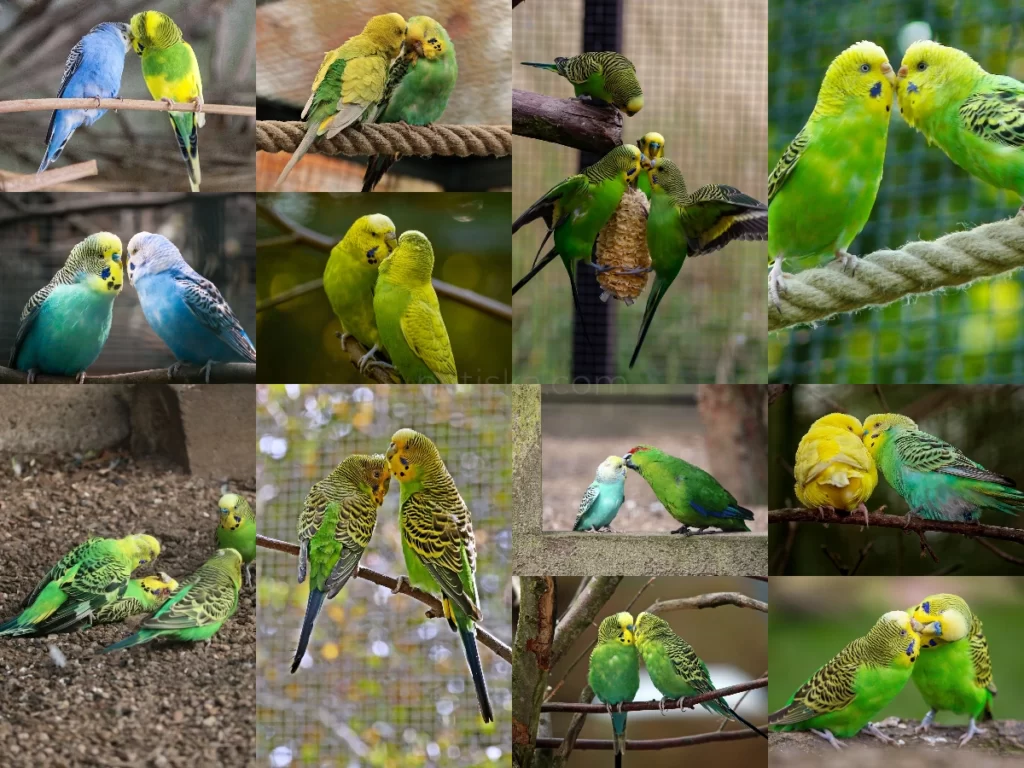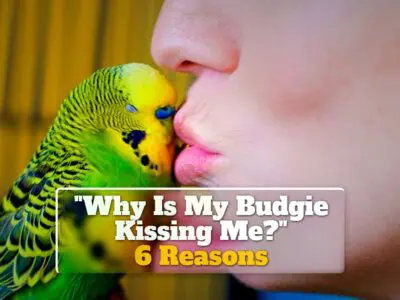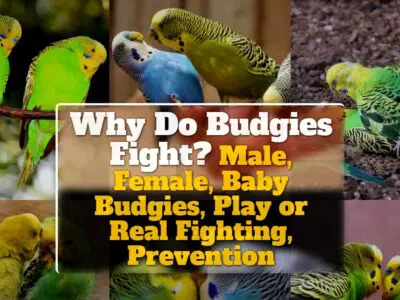There’s something truly heartwarming about watching your budgies engaging in what appears to be a tender kiss.
But as someone fascinated by these small, intelligent birds, one can’t help but question the intent behind such an act.
Are they expressing love or dominance, or simply communicating?
Budgie kissing is a multi-faceted behavior, expressing a variety of emotions and actions such as bonding, feeding each other, communication, and play.
Sometimes, it’s a form of conflict resolution, while at other times, it can be a sign of affection or mirroring behavior.
However, it’s crucial to differentiate it from fighting which is typically marked by aggressive body language.

What Are The Reasons Budgies Kiss Each Other?
Budgies are social creatures with a complex web of behaviors.
It is fascinating to observe their interaction, particularly the act that resembles a human kiss.
As a budgie owner, understanding these behaviors helps to ensure a harmonious and healthy environment for these fascinating birds.
It’s crucial to recognize that what might seem like a “kiss” might actually be an expression of various behavioral nuances from feeding, bonding, courtship, establishing social hierarchy, to communication.
Feeding Behavior (Feeding Each Other)
In the world of budgies, sharing is caring, especially when it comes to feeding.
You might have observed your budgies with their beaks close together, seemingly indulged in a romantic “kiss.” However, this could very well be an instance of budgies feeding each other.
This practice is common, particularly between parent budgies and their chicks.
It might seem off-putting to human observers, but this regurgitation of food is an integral part of their nurturing process. In addition, the male budgerigar regurgitate food to the female budgie (kissing) instead of feeding the chicks directly.
Bonding Behavior
Budgies have a unique way of establishing and strengthening their social ties.
One such method involves what appears to us as “kissing.” This bonding behavior involves mutual grooming, including beak rubbing and other physical acts of intimacy.
Such displays of camaraderie are especially prevalent among mated pairs, reinforcing their bond and ensuring a unified front in the face of any adversities.
Courtship Behavior
In the charming realm of budgie courtship, “kissing” plays a critical role.
The male budgie often indulges in this act as a means of wooing the female.
This display is more than a mere romantic gesture; it’s the male’s way of demonstrating his capability to provide for the potential mate and future offspring.
Social Hierarchy
In a budgie flock, not all “kisses” are born out of affection or courtship.
Some serve to establish social order.
A dominant bird may engage in “kissing” behavior with a subordinate one as a means of asserting its position in the hierarchy.
While it might seem like a tender interaction to us, it’s an act laden with power dynamics in the budgie world.
Communication
Budgies communicate in a variety of ways, and ‘kissing’ is one of these channels of communication.
Budgies may use this form of interaction to signal contentment, desire for attention, or an invitation to play.
They might peck or lightly nibble at each other’s beaks as a gentle nudge, a way to draw attention, or even show their readiness for a friendly activity.
If we closely observe, we can see a pattern in these interactions and might be able to decipher what these little feathery creatures are trying to communicate.
Preening
One of the most common forms of interactions among budgies is preening.
This is a mutual grooming behavior that helps keep their feathers in top shape.
Budgies spend a significant portion of their day preening themselves and each other.
This is not only a practical behavior for physical cleanliness and feather maintenance but also serves a vital social function.
When budgies preen each other, it reinforces social bonds, helps build trust, and eases tension within the flock.
This mutual preening often includes beak touching and nibbling that could be mistaken for ‘kissing.’ It is indeed an intimate interaction, but it’s more akin to a mutual spa day than a romantic kiss.
Affection
And yes, like many other pet birds, budgies are capable of forming strong emotional bonds.
These bonds can be with their human caretakers or with other budgies.
Such bonds often manifest in behaviors that we interpret as signs of affection.
Their beak-to-beak interactions or ‘kissing’ could indeed be their way of expressing affection towards each other.
It is a part of their language of love.
So, next time when you see your budgies locking their beaks or lightly pecking at each other, they might just be saying, “I cherish you, mate!”
Mirroring Behavior
Budgies are quite the social mimic.
They have an impressive ability to mirror behaviors observed in their environment.
They can emulate sounds, gestures, and yes, even the affectionate behavior of ‘kissing’ that they might have observed in their human caregivers.
This doesn’t mean your budgie is necessarily feeling romantic, but it’s demonstrating its intelligence and adaptability by mimicking a behavior it has observed.
Learning Behavior
For young budgies, the world is a vast playground ripe for exploration and learning.
Their social interactions, including what appears to us as ‘kissing,’ often have roots in learning behavior.
Young budgies may lock beaks and appear to ‘kiss’ more frequently as they experiment with their social environment, testing out different interactions and reactions.
It is an essential part of their growth and understanding of social dynamics within their flock.
Play Behavior
Play is integral to budgies’ daily routine.
It keeps their minds active, their bodies exercised, and their social bonds strengthened.
One of these play behaviors may include what looks like ‘kissing.’ But it could simply be a playful interaction, with budgies enjoying a bit of beak fencing or other close contact activities.
In the end, it’s all about fun and games in the playful world of budgies.
Showing Trust
A budgie extending its beak towards another is not only an interaction but a sign of trust.
It indicates that the budgie feels safe and secure with its companion.
This act, akin to ‘kissing,’ is an intimate interaction, expressing a deep level of comfort and trust between the two birds.
By allowing another close to its beak, a vital and vulnerable part of its body, a budgie is signaling its trust in its mate or friend.
Boredom
Just like us, budgies can also experience boredom.
In a cage with limited activities, these bright and active birds might resort to various behaviors to keep themselves entertained, and one of them can be ‘kissing.’ If their environment lacks mental and physical stimulation, they might start exploring other avenues of interaction, including increased beak to beak contact.
This is a reminder to us that these intelligent creatures need an enriched environment full of engaging toys and activities.
Stress Relief
Stress relief is an essential aspect of budgies’ behavioral repertoire.
‘Kissing’ or similar behaviors can be a way for budgies to calm themselves down in stressful situations.
It’s a form of self-soothing, a comfort gesture that helps them feel better.
So, if your budgies are kissing each other during a thunderstorm or after a scary encounter with the house cat, they might be trying to console each other and reduce their stress levels.
Personalities
Just as every human is unique, so is every budgie.
Each has its own personality, preferences, and habits.
Some budgies might be more inclined towards ‘kissing’ behavior than others, purely based on their individual personality.
It doesn’t necessarily have a deeper meaning than that.
It could simply be that your budgie enjoys these close beak interactions more than its peers.
Conflict Resolution
Birds, like budgies, have their own unique ways of dealing with conflicts.
One such method can be what we interpret as ‘kissing.’ It might be their way of making up after a squabble or establishing peace within their flock.
The intimate beak interaction can be a mechanism to defuse tension and resolve conflicts, signaling to each other and the rest of the flock that harmony has been restored.
It’s their feathery version of “Let’s kiss and make up.”
FAQs
How Do I Know If My Budgies Are Kissing Or Fighting?
While it can be challenging to differentiate between a budgie kiss and a fight, several signs can help.
For instance, if the interaction is accompanied by aggressive body language, loud squawking, or plucking feathers, it’s more likely a fight.
On the other hand, a gentle, relaxed interaction is likely to be a “kiss.”
Does A Male Budgie Kiss Another Male Budgie?
Yes, male budgies can “kiss” each other.
It’s not always a romantic or mating behavior.
It can be a sign of bonding, social hierarchy, or simply an act of communication between them.
Does A Female Budgie Kiss Another Female Budgie?
Yes, female budgies can engage in “kissing” behavior too.
Similar to males, this interaction serves various purposes like strengthening bonds, establishing hierarchy, and communication.
Is Kissing Behavior Unique To Budgies?
No, “kissing” behavior is not unique to budgies.
Other bird species, like lovebirds and cockatiels, also engage in similar behaviors.
It’s a common form of social interaction among many avian species.
What Should I Do If My Budgies Start Fighting After Kissing?
If your budgies start fighting after what seemed to be a “kiss,” it’s essential to monitor their behavior closely.
If the aggression continues, you might need to separate them temporarily for their safety and consult with a vet or avian expert.
Do All Budgies Kiss?
While “kissing” is a common behavior among budgies, it doesn’t mean all budgies will exhibit it.
Each budgie is unique with its own set of behaviors and personality traits.
Is Kissing A Sign Of A Healthy Relationship In Budgies?
“Kissing” can indeed be a sign of a healthy relationship among budgies, symbolizing trust, bonding, and communication.
However, it’s also essential to observe other signs of their health and happiness, such as their appetite, vocalizations, and activity levels.
Is Budgie Kissing A Learned Behavior Or Instinctual?
It’s a combination of both.
Some aspects of ‘kissing,’ like feeding each other, are instinctual and important for survival.
Other behaviors like mirroring might be learned from their environment or through interaction with other budgies.
It’s a complex behavior shaped by both innate traits and experiences.
Can Budgie Kissing Be Harmful To Their Health?
No, budgie kissing is not harmful to their health.
It’s a natural behavior that plays a crucial role in their social interactions.
However, if the birds are not well acquainted or if a conflict arises, this behavior might escalate to fighting, which could potentially cause harm.
Do Budgies Kiss Other Bird Species?
Budgies primarily interact with their own kind, and their behaviors, such as ‘kissing,’ are typically directed at other budgies.
In a domestic setting, a budgie raised with other bird species might exhibit similar behaviors with them, but it largely depends on individual personalities and the compatibility of the species involved.
However, caution must be exercised when housing different bird species together.
It’s important to ensure all birds are comfortable and safe, and any interaction, including ‘kissing,’ should be closely monitored to prevent potential conflicts.


